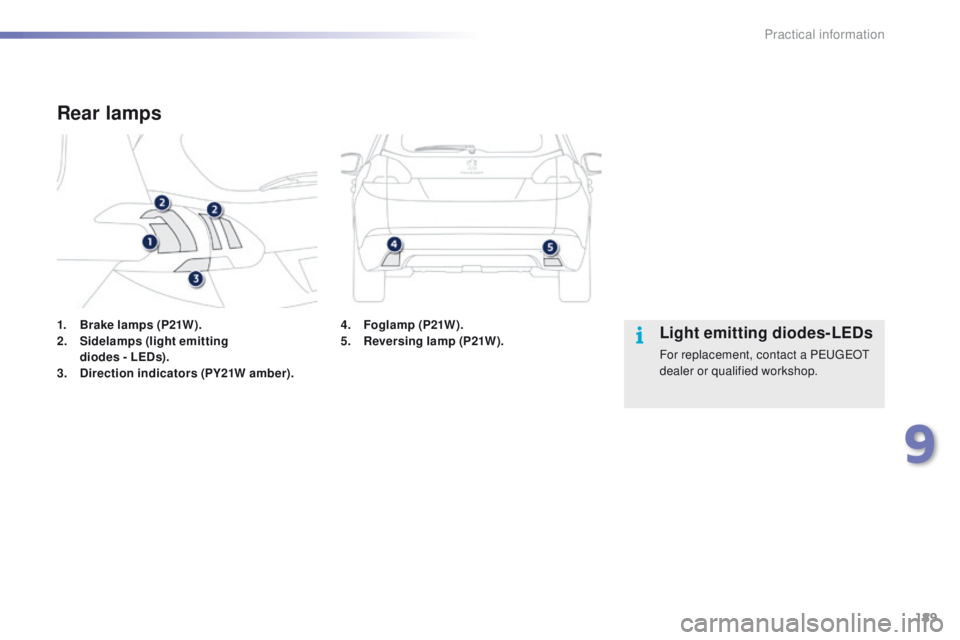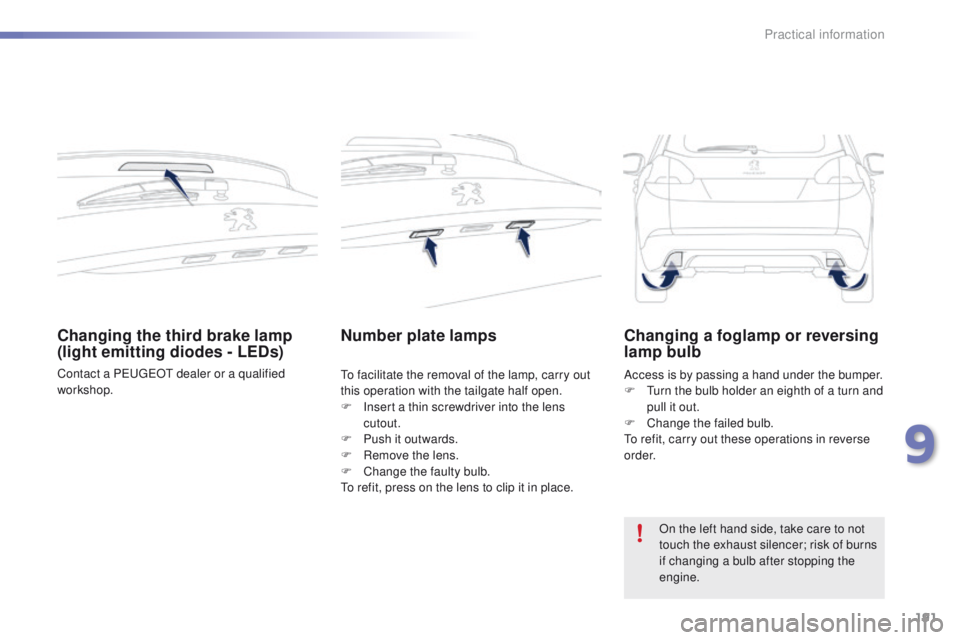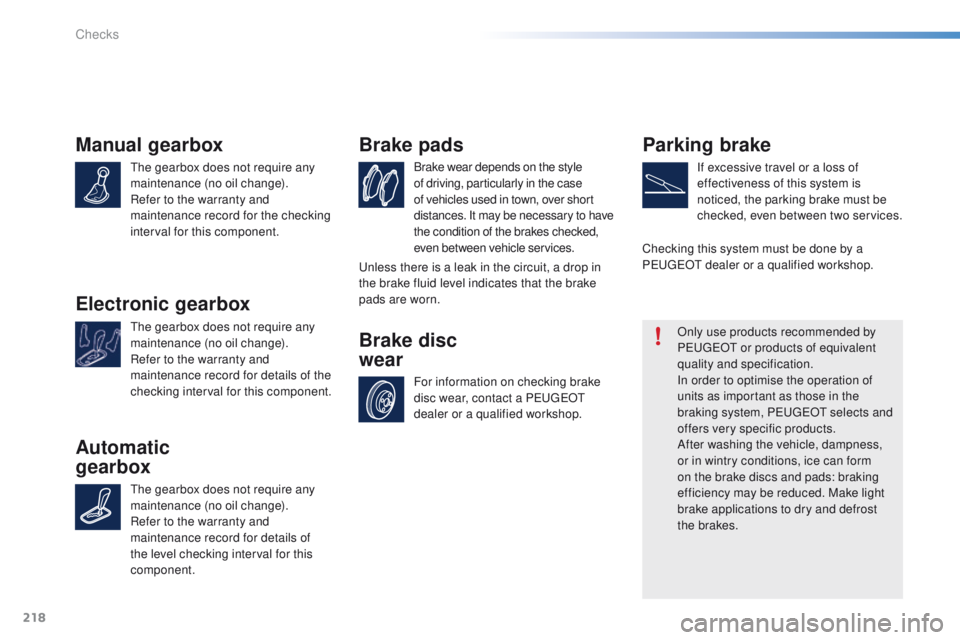2015 PEUGEOT 2008 brake light
[x] Cancel search: brake lightPage 191 of 340

189
2008_en_Chap09_info-pratiques_ed01-2015
1. Brake lamps (P21W).
2. Sidelamps (light emitting
diodes - LEDs).
3.
D
irection indicators (PY21W amber).
Rear lamps
Light emitting diodes-LEDs
For replacement, contact a PEUGEOT
dealer or qualified workshop.
4.
F
oglamp (P21W).
5. R
eversing lamp (P21W).
9
Practical information
Page 193 of 340

191
2008_en_Chap09_info-pratiques_ed01-2015
Changing the third brake lamp
(light emitting diodes - LEDs)
Contact a PEUGEOT dealer or a qualified
workshop.
Number plate lamps
To facilitate the removal of the lamp, carry out
this operation with the tailgate half open.
F
I
nsert a thin screwdriver into the lens
cutout.
F
P
ush it outwards.
F
R
emove the lens.
F
C
hange the faulty bulb.
To refit, press on the lens to clip it in place. Access is by passing a hand under the bumper.
F
T urn the bulb holder an eighth of a turn and
pull it out.
F
C
hange the failed bulb.
To refit, carry out these operations in reverse
o r d e r.
Changing a foglamp or reversing
lamp bulb
On the left hand side, take care to not
touch the exhaust silencer; risk of burns
if changing a bulb after stopping the
engine.
9
Practical information
Page 208 of 340

206
2008_en_Chap09_info-pratiques_ed01-2015
Driving advice
Distribution of loads
F Distribute the load in the trailer so that the heaviest items are as close as possible to
the axle and the nose weight approaches
the maximum permitted without
exceeding
it.
Air density decreases with altitude, thus
reducing engine performance. Above
1
000 metres, the maximum towed load must
be reduced by 10
% for every 1 000 metres of
altitude.
Side wind
F Take into account the increased sensitivity to side wind.
Cooling
Towing a trailer on a slope increases the
temperature of the coolant.
As the fan is electrically controlled, its cooling
capacity is not dependent on the engine speed.
F
T
o lower the engine speed, reduce your
speed.
The maximum towed load on a long incline
depends on the gradient and the ambient
temperature.
In all cases, keep a check on the coolant
temperature.
F
I
f the warning lamp and
the
STOP warning lamp come
on, stop the vehicle and switch
off the engine as soon as
possible.
Braking
Towing a trailer increases the braking distance.
To avoid overheating of the brakes on a long
mountain type of descent, the use of engine
braking is recommended.
Ty r e s
F Check the tyre pressures of the towing vehicle and of the trailer, observing the
recommended pressures.
Lighting
F Check the electrical lighting and signalling on the trailer.
The rear parking sensors will be
deactivated automatically if a genuine
PEUGEOT towbar is used.
Refer to the "Technical data" section for details
of the weights and towed loads which apply to
your vehicle.
Practical information
Page 220 of 340

218
2008_en_Chap10_verifications_ed01-2015
Manual gearbox
The gearbox does not require any
maintenance (no oil change).
Refer to the warranty and
maintenance record for the checking
interval for this component.
Electronic gearbox
The gearbox does not require any
maintenance (no oil change).
Refer to the warranty and
maintenance record for details of the
checking interval for this component.
Automatic
gearbox
The gearbox does not require any
maintenance (no oil change).
Refer to the warranty and
maintenance record for details of
the level checking interval for this
component.Brake wear depends on the style
of driving, particularly in the case
of vehicles used in town, over short
distances. It may be necessary to have
the condition of the brakes checked,
even between vehicle services.
Brake pads
For information on checking brake
disc wear, contact a PEUGEOT
dealer or a qualified workshop.
Brake disc
wear
Parking brake
If excessive travel or a loss of
effectiveness of this system is
noticed, the parking brake must be
checked, even between two services.
Only use products recommended by
PEUGEOT or products of equivalent
quality and specification.
In order to optimise the operation of
units as important as those in the
braking system, PEUGEOT selects and
offers very specific products.
After washing the vehicle, dampness,
or in wintry conditions, ice can form
on the brake discs and pads: braking
efficiency may be reduced. Make light
brake applications to dry and defrost
the brakes.
Checking this system must be done by a
PEUGEOT dealer or a qualified workshop.
Unless there is a leak in the circuit, a drop in
the brake fluid level indicates that the brake
pads are worn.
Checks
Page 221 of 340

219
2008_en_Chap11_caracteristiques-techniques_ed01-2015
General information
Towing with a lightly loaded vehicle can
adversely affect roadholding.
Braking distances are increased when
towing a trailer.
The speed of a towing vehicle must not
exceed 60 mph (100 km/h) (comply with
the legislation in force in your country). High ambient temperatures may result
in a reduction in the per formance of the
vehicle to protect the engine; when the
ambient temperature is higher than
37 °C, limit the towed weight.
Engine characteristicsWeights and towed
loads
The engine characteristics (capacity,
maximum power, maximum power speed, fuel,
CO
2 emissions...) for your vehicle are given in
t
he registration document, as well as in sales
brochures.
These characteristics correspond to the
values type-approved on a test bed, under
conditions defined in European legislation
(Directive
1999/99/EC).
For more information, contact a PEUGEOT
dealer or a qualified workshop. The maximum weights and towed loads for your
vehicle are given are given in the registration
document, as well as in sales brochures.
These values are also present on the
manufacturer's plate or label (see the
"Identification markings" section).
For more information, contact a PEUGEOT
dealer or a qualified workshop.
The kerb weight is equal to the unladen
weight
+ driver (75 kg).
The gross train weight and towed load values
indicated apply up to a maximum altitude of
1 000 metres; the towed load mentioned
must be reduced by 10 % for every additional
1
000 metres.
The weight of the braked trailer can be
increased, within the GTW limit, on condition
that the GV W of the towing vehicle is reduced
by the same amount.
The recommended nose weight is the vertical
load on the towbar ball (removable with or
without tools).
GV W:
gross vehicle weight, the maximum authorised vehicle weight.GT W: gross train weight, the maximum authorised weight of vehicle plus trailer.
11
Technical data
Page 224 of 340

222
2008_en_Chap11_caracteristiques-techniques_ed01-2015
* The kerb weight is equal to the unladen weight + driver (75 kg).
** T he weight of the braked trailer can be increased, within the GTW limit, if the GV W of the towing vehicle is reduced by an equal amount; warning,
towing using a lightly loaded towing vehicle may have an adverse effect on its road holding.
Weights and towed loads (in kg) - PETROL
Engine 1.2 litre PureTech 821.2 litre PureTech 82
S&S 1.2 litre PureTech 110
S&S
Gearbox Manual
(5-speed) ETG5 electronic
(5-speed) ETG5 electronic
(5-speed) Manual
(5-speed)
Model code:
C
UHMZ0
HMZ6 HMZ0/P
HMZ6/PS HNZ6/S
-
U
nladen weight 1 0451 0551 0551 090
-
K
erb weight* 1 1201 13 0 1 13 01 165
-
G
ross vehicle weight
(GV W) 1 582
1 5731 593 1 656
-
G
ross train weight (GTW)
o
n a 12 % gradient 2 362
2 0232 043 2 606
-
B
raked trailer (within GTW limit)
o
n a 10 % or 12 % gradient 780
450 450950
-
B
raked trailer** with load transfer
(within the GTW limit) 1 10 0
7707701 270
-
U
nbraked trailer 560450450580
-
R
ecommended nose weight 51515151
The GTW and towed load values indicated are valid up to a maximum altitude of 1 000 metres; the towed load mentioned must be reduced by 10 % for
each additional 1 000 metres of altitude.
The speed of a towing vehicle must not exceed 60 mph (100 km/h) (comply with the legislation in force in your country).
High ambient temperatures may result in a reduction in the per formance of the vehicle to protect the engine; if the ambient temperature is above 37 °C,
limit the towed load.
Technical data
Page 225 of 340

223
2008_en_Chap11_caracteristiques-techniques_ed01-2015
Weights and towed loads (in kg) - PETROL
Engine1.2 litre PureTech 130
S&S 1.6 litre VTi 120
Gearbox Manual
(6-speed) Manual
(5-speed) Automatic
(4-speed)
Model code:
C
UHNYM/S 5FS05FS9
-
U
nladen weight 1 1601 080 1 140
-
K
erb weight* 1 2351 1551 215
-
G
ross vehicle weight
(GV W) 1 675
1 644 1 666
-
G
ross train weight (GTW)
o
n a 12 % gradient 2 625
2 6142 616
-
B
raked trailer (within GTW limit)
o
n a 10 % or 12 % gradient 950
970950
-
B
raked trailer** with load transfer
(within the GTW limit) 1 270
1 270 1270
-
U
nbraked trailer 580570600
-
R
ecommended nose weight 515151
The GTW and towed load values indicated are valid up to a maximum altitude of 1 000 metres; the towed load mentioned must be reduced by 10 % for
each additional 1 000 metres of altitude.
The speed of a towing vehicle must not exceed 60 mph (100 km/h) (comply with the legislation in force in your country).
High ambient temperatures may result in a reduction in the per formance of the vehicle to protect the engine; if the ambient temperature is above 37 °C,
limit the towed load.
*
T
he kerb weight is equal to the unladen weight + driver (75 kg).
**
T
he weight of the braked trailer can be increased, within the GTW limit, if the GV W of the towing vehicle is reduced by an equal amount; warning,
towing using a lightly loaded towing vehicle may have an adverse effect on its road holding.
11
Technical data
Page 228 of 340

226
2008_en_Chap11_caracteristiques-techniques_ed01-2015
Weights and towed loads (in kg) - DIESEL
* The kerb weight is equal to the unladen weight + driver (75 kg).
** T he weight of the braked trailer can be increased, within the GTW limit, if the GV W of the towing vehicle is reduced by an equal amount; warning,
towing using a lightly loaded towing vehicle may have an adverse effect on its road holding.
Engine
1.4 litre HDi 681.6 litre BlueHDi 75
Gearbox Manual
(5-speed) Manual
(5-speed)
Model code:
C
U
8HR0 BHW6
-
U
nladen weight
1 0901 160
-
K
erb weight*
1 1651 235
-
G
ross vehicle weight
(GV W) 1 622
1 680
-
G
ross train weight (GTW)
o
n a 12% gradient
1 972
2 300
-
B
raked trailer (within GTW limit)
o
n a 10% or 12% gradient
350
620
-
B
raked trailer** with load transfer
(within the GTW limit) 670
940
-
U
nbraked trailer
350610
-
R
ecommended nose weight
5151
The GTW and towed load values indicated are valid up to a maximum altitude of 1 000 metres; the towed load mentioned must be reduced by 10 % for
each additional 1 000 metres of altitude.
The speed of a towing vehicle must not exceed 60 mph (100 km/h) (comply with the legislation in force in your country).
High ambient temperatures may result in a reduction in the per formance of the vehicle to protect the engine; if the ambient temperature is above 37 °C,
limit the towed load.
Technical data